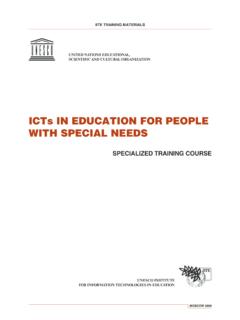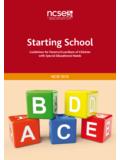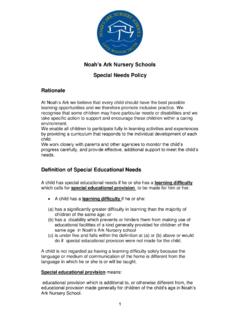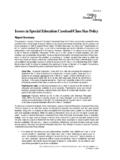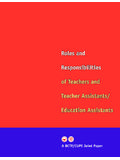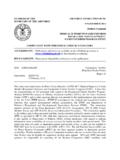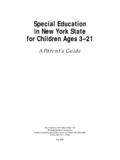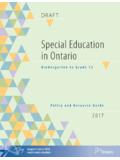Transcription of CX3.1 Special Educational Needs (SEN) - OECD.org - OECD
1 OECD Child well-being Module OECD - Social policy Division - Directorate of Employment, Labour and Social Affairs 1 Updated 14 May 2012 Special Educational Needs (SEN) Definitions and methodology This indicator presents information on the proportions of children with Special Educational Needs (SEN) in OECD countries. Definitions of SEN vary widely across countries as they are specific to each country s legislation (see Table ). Some countries define SEN using a general definition of disabled children, others categorise SEN pupils into more than ten different categories.
2 However, differences in national definitions should not be exaggerated and do not preclude international comparisons of the available data. A child is commonly recognised as having Special Educational Needs (SEN) if he or she is not able to benefit from the school education made generally available for children of the same age without additional support or adaptations in the content of studies. Therefore, SEN can cover a range of Needs including physical or mental disabilities, and cognition or Educational The percentage of children with SEN reported here is calculated by dividing the number of children with SEN by the total number of children enrolled at school (multiplied by 100).
3 This indicator covers compulsory school-aged children and as such cannot be treated as a total child population rate. Key Findings In the last 25 years, there has been global agreement that all children have the right to be formally educated individually and/or together, including children who have Special Educational Needs . It is enshrined in the Convention on the Rights of the Child (United Nations, 1989), as well as the Convention on the Rights of Persons with Disabilities (United Nations, 2008). Inclusive education for children with SEN is also addressed in several significant international declarations, including the World Declaration for Education for All (United Nations, 1990), the UNESCO Salamanca Statement and Framework for Action (1994), and the Dakar Framework for Action (2000).
4 Yet despite recent international consensus on the rights of children with SEN, and efforts to find an international definition agreed by all the countries who signed theses conventions, data on children with SEN are still being collected according to national definitions. Other relevant indicators: OECD Family database Educational attainment ( );. Child well-being module Literacy scores at age 10 ( ); Literacy scores at age 15 ( ). 1 UNESCO (2011), Revision of the International Standard Classification of Education (ISCED).
5 Special Education Needs is Education designed to facilitate the learning of individuals who, for a wide variety of reasons, require additional support and adaptive pedagogical methods in order to participate and meet learning objectives in an Educational programme. Reasons may include (but are not limited to) disadvantages in physical, behavioural, intellectual, emotional and social capacities. Educational programmes in Special Needs education may follow a similar curriculum as that offered in the parallel regular education system, however they take individuals particular Needs into account by providing specific resources ( specially trained personnel, equipment, or space) and, if appropriate, modified Educational content or learning objectives.
6 These programmes can be offered for individual learners within already existing Educational programmes, or be offered as a separate class in the same or separate Educational institutions . (p. 83) OECD Child well-being Module OECD - Social policy Division - Directorate of Employment, Labour and Social Affairs 2 Updated 14 May 2012 Chart presents the rates of children who have SEN as the proportion of total compulsory school-aged pupils in 27 OECD countries. Based on national definitions, Iceland stands out as a country with the highest proportion of SEN statements, at nearly 1 in 4 children.
7 In the remaining countries, the proportion of children with SEN varies from 1% in Korea to above 10% in the United States. These large differences will, in no small part, be attributable to the differences in national definitions and the inclusion or not of children with some specific disabilities or disorders in the category of children with SEN (see Table for complete definitions). In Iceland, data referring to children who are recognised as having some form of Special need that requires any additional support are included - for example children with reading difficulties are considered as receiving support with additional Educational material.
8 This definition is wide, and so it explains the high percentage of children falling into this category in Iceland. In contrast, Greece and Sweden only count children who attend Special programmes and who are included in Special schools or Special classes. Children who have Educational Needs in mainstream schools are not counted by Greece or Sweden, which help to explain the low percentages. Chart Children with SEN represent less than a tenth in most OECD countries Percentage of school aged pupils with SEN, 2007-20101 1. Academic school year 2007/2008 for Germany, Portugal, Spain; 2008/2009 for Austria, Belgium, Denmark, Finland, France, Hungary, Iceland, Ireland, Italy, Luxembourg, Sweden, Switzerland, the United Kingdom and the United States; 2009/2010 for Australia, Czech Republic, Estonia, Greece, Japan, Korea, the Netherlands, Norway, Poland, Slovenia.
9 Data for Belgium and the United Kingdom have been aggregated across the different jurisdictions. Source: for European countries: European Agency for Development in Special Needs Education, for Australia, Japan and Korea: National Institute of Special Needs (Japan) and for the United States: Individuals with Disabilities Education Act. Across countries, children with SEN are either in segregated Special schools or in segregated Special classes in mainstream schools for the largest part 80% or more - of the school day, or in regular classes in mainstream schools.
10 Table provides information on the number of children with SEN 051015202530% OECD Child well-being Module OECD - Social policy Division - Directorate of Employment, Labour and Social Affairs 3 Updated 14 May 2012 by settings in OECD countries where data are available. Where disaggregated data are not available, this is because national statistics are not collected at this level of detail. The 2010 data shows that most of the countries already have a large proportion of children in totally inclusive settings. Iceland, Ireland, Italy, Norway, Portugal and Spain have included more than 75% of children with SEN in mainstream classes in mainstream schools in 2010.










